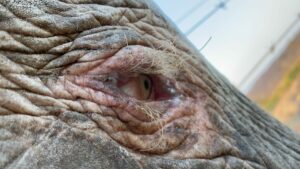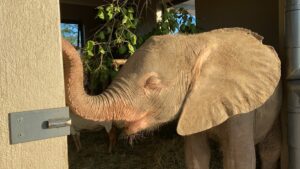In this blog, we focus on Khanyisa’s eyesight as an albino elephant. One of the first things people notice about Khanyisa are her eyes. Unlike the other elephants in the herd, Khanyisa has extremely light eyes – from a distance her eyes may even look white. We frequently receive questions about Khanyisa’s eyes, as people are understandably concerned about her and how her albinism may affect her eyes as she gets older. Here are the answers to all the questions you may have.
What does it mean to be an albino?
A person or animal without pigment in their skin, hair and eyes is called an albino. Albinism is often confused with leucism, which is a condition that causes partial loss of pigmentation. Generally, animals with albinism have no pigment in their eyes, whereas animals with leucism do have pigment in their eyes, but this is not always the case for all animals.

How does albinism affect eyes and eyesight?
The pigment in eyes is what absorbs light and helps people and animals to tolerate bright light. As albinos have no pigment in their eyes, their eyes cannot absorb light and cannot tolerate bright light very well. We refer to this as photosensitivity.
Albinism also affects eyesight. The pigment in eyes contributes to the function of many parts of the eyes, and therefore the lack of pigment in the eyes of albinos causes their eyes to develop abnormally. There is a lack of research on how exactly albinism affects eye development, and there is evidence that the degree of abnormal development differs between species. It is likely that most albinos struggle to focus and to perceive depth.
Elephants rely much more on their other senses such as touch and smell, and chemical messages read through the Jacobson’s organ, and much less on eyesight. Therefore Khanyisa is fully able to communicate naturally with her herd and the surrounding wilderness using her growing trunk and the hairs on her body that are so sensitive to touch.
[Source: research published by R.W. Guillery]
Do Khanyisa’s eyes and eyesight make it difficult for her to fit in with the herd?
Khanyisa’s eyes and eyesight aren’t very different from that of other elephants. Elephants can’t see very well in bright light, but can see quite well in low light. Their eyes are also a bit sensitive to the sun, which is why you will sometimes see elephants with half-closed eyes in bright sunlight. Older elephants will stand over or near calves to provide them with shade. All of this means that the elephants already naturally behave in ways that benefit and protect Khanyisa. She won’t struggle to fit in or to participate in anything the other elephants are doing.
People often ask us if the elephants can tell that Khanyisa is an albino. Read our answer here >
Will Khanyisa’s condition get worse over time? Will she become blind?
Albinism is non-progressive, which means that it does not worsen over time. Current research indicates that albinos’ eyesight remains quite stable as they age. Khanyisa will always be an albino, but her condition will not worsen as she gets older.
Why does Khanyisa’s skin sometimes look dark?
Elephants cover themselves with mud and sand in order to protect their skin from parasites and the sun’s ultraviolet rays, as well as to help them stay cool. When Khanyisa covers herself with mud and sand, her skin looks darker. Once the mud and sand is washed off in water, her skin will look pink again.
You can recognise albino elephants – even when they are covered in mud – by looking at their light eyelashes and tail hair, their light eyes, the pink soles of their feet, and the pink patches of skin where there is no mud.

Could Khanyisa get skin cancer or eye cancer?
Elephants are extremely resistant to all types of cancer. They have extra copies of a gene that fights tumour cells, but the exact reasons for their resistance to cancer are still being studied. This means that though cancer is a concern for most albino animals, it is very unlikely to be a problem for albino elephants like Khanyisa.
[Source: research published by J.D. Schiffman and V.J. Lynch]
Why don’t you give Khanyisa sunglasses or protective eyewear?
We have considered protective eyewear, but it would be impossible to create eyewear that would not harm or endanger Khanyisa. She might try to remove the eyewear with her trunk, or one of the other elephants might try to remove or pull at it. The eyewear could also get caught on objects, or objects could get stuck on or inside the eyewear. Elephants continuously cover themselves with mud, dust and sand, all of which could get stuck in the eyewear. The eyewear would also quickly become too small for Khanyisa’s growing head and body and would need to be replaced regularly.
We have chosen to let Khanyisa continue without protective eyewear. Elephants naturally behave in ways that protect their eyes, such as keeping their eyes half-closed in bright light and seeking shade under large trees. Khanyisa will continue to learn from the older elephants in the herd and will learn how to protect her eyes. The two wild albino elephants in our reserve appear to have no problems with navigating their world, which is a good indication that Khanyisa won’t struggle.
The lack of research on albino animals – and on albino elephants specifically – means that we cannot know exactly how Khanyisa’s albinism will affect her throughout her life. Much of our knowledge comes from observing the two albino elephants in our reserve; both of them are doing well and do not appear to be negatively affected by their conditions. They haven’t been rejected by their herds, and one of the females has happily birthed her own calf and continues to be a dedicated mother to her daughter. Of course, Khanyisa herself also gives us insight into her own condition as she grows and changes and we are able to compare her growth to other orphans we have rehabilitated and integrated. We are continuing to compile data in order to contribute research to this field.
If you would like to foster Khanyisa you can do so here.




 Comment
Comment






